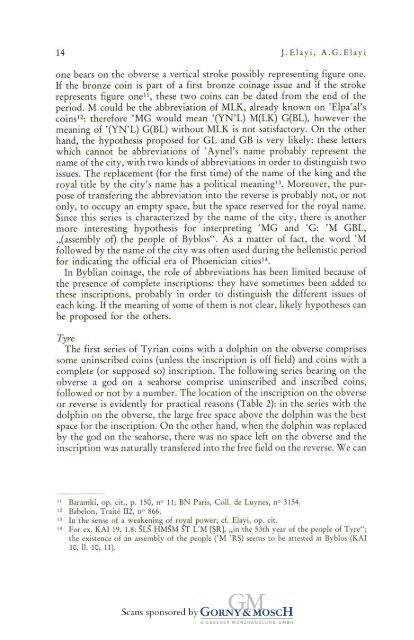jahrbuch numismatik geldgeschichte - Medievalcoinage.com
jahrbuch numismatik geldgeschichte - Medievalcoinage.com
jahrbuch numismatik geldgeschichte - Medievalcoinage.com
Erfolgreiche ePaper selbst erstellen
Machen Sie aus Ihren PDF Publikationen ein blätterbares Flipbook mit unserer einzigartigen Google optimierten e-Paper Software.
14 J. Elayi, A.G.Elayi<br />
one bears on the obverse a vertical stroke possibly representing figure one.<br />
If the bronze coin is part of a first bronze coinage issue and if the stroke<br />
represents figure one", these two coins can be dated from the end of the<br />
period. M could be the abbreviation of MLK, already known on 'Elpa'al's<br />
coins12: therefore `MG would mean IYN'L) MILK) G(BL), however the<br />
meaning of IYN'L) G(BL) without MLK is not satisfactory. On the other<br />
hand, the hypothesis proposed for GL and GB is very likely: these letters<br />
which cannot be abbreviations of 'Aynel's name probably represent the<br />
name of the city, with two kinds of abbreviations in order to distinguish two<br />
issues. The replacement (for the first time) of the name of the king and the<br />
royal title by the city's name has a political meaning13. Moreover, the purpose<br />
of transfering the abbreviation into the reverse is probably not, or not<br />
only, to occupy an empty space, but the space reserved for the royal name.<br />
Since this series is characterized by the name of the city, there is another<br />
more interesting hypothesis for interpreting `MG and `G: 'M GBL,<br />
„(assembly of) the people of Byblos". As a matter of fact, the word 'M<br />
followed by the name of the city was often used during the hellenistic period<br />
for indicating the official era of Phoenician cities14.<br />
In Byblian coinage, the role of abbreviations has been limited because of<br />
the presence of <strong>com</strong>plete inscriptions: they have sometimes been added to<br />
these inscriptions, probably in order to distinguish the different issues of<br />
each king. If the meaning of some of them is not clear, likely hypotheses can<br />
be proposed for the others.<br />
Tyre<br />
The first series of Tyrian coins with a dolphin on the obverse <strong>com</strong>prises<br />
some uninscribed coins (unless the inscription is off field) and coins with a<br />
<strong>com</strong>plete (or supposed so) inscription. The following series bearing on the<br />
obverse a god on a seahorse <strong>com</strong>prise uninscribed and inscribed coins,<br />
followed or not by a number. The location of the inscription on the obverse<br />
or reverse is evidently for practical reasons (Table 2): in the series with the<br />
dolphin on the obverse, the large free space above the dolphin was the best<br />
space for the inscription. On the other hand, when the dolphin was replaced<br />
by the god on the seahorse, there was no space left on the obverse and the<br />
inscription was naturally transfered into the free field on the reverse. We can<br />
" Baramki, op. cit., p. 150, n° 11; BN Paris, Coll. de Luynes, n° 3154.<br />
12 Babelon, Traite 112, n° 866.<br />
13 In the sense of a weakening of royal power; cf. Elayi, op. cit.<br />
14 For ex. KAI 19, 1.8: gLg HMgM gT [SR], „in the 53th year of the people of Tyre";<br />
the existence of an assembly of the people ('M 'RS) seems to be attested at Byblos (KAI<br />
10, 11. 10, 11).

















